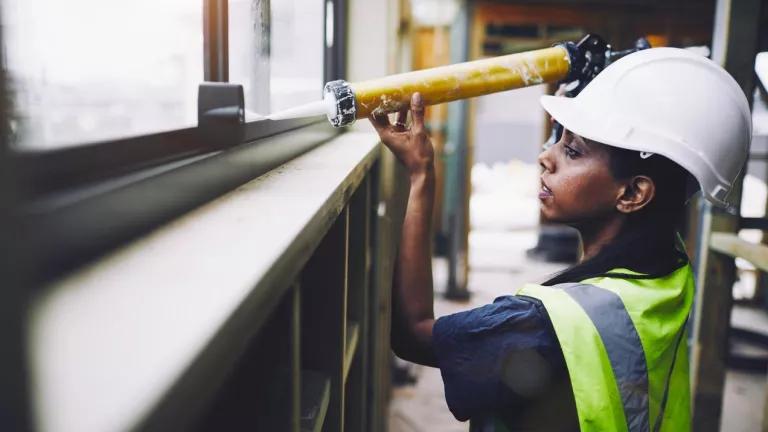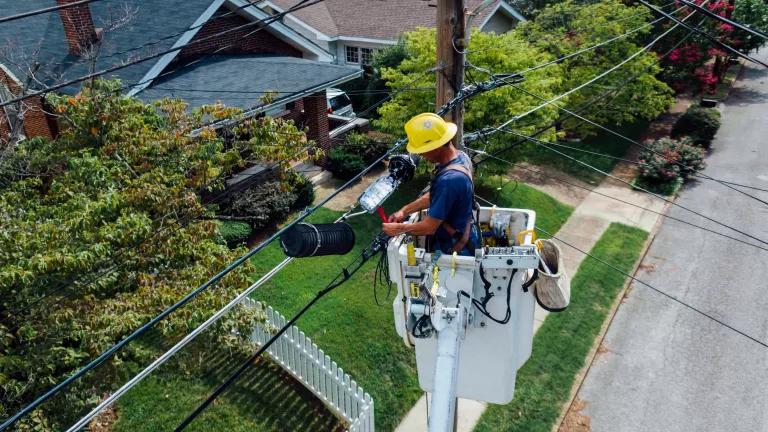How to Plan for Equitable Energy Efficiency in a Pandemic
As the ongoing pandemic further exacerbates racial and economic disparities across America, it is important to examine whether programs aimed at helping utility customers cut energy waste are reaching everyone.

Part 4 of a 4-Part Series (Part 1, Part 2, and Part 3)
As the ongoing pandemic further exacerbates racial and economic disparities across America, it is important to examine whether programs aimed at helping utility customers cut energy waste are reaching everyone. Fortunately, there are ways to ensure energy efficiency program planning prioritizes people with the highest energy insecurity, cutting their energy costs and improving their health and comfort while cleaning the air and staving off harmful climate pollution.
Approximately $8 billion is invested annually in energy-saving programs by the nation’s investor-owned and municipal utilities from charges on customer bills. But what does energy efficiency program planning look like when many people are sheltering-in-place and concerned about coronavirus exposure, and also may be unemployed and/or experiencing a substantial reduction in income?
Designing efficiency programs during an unprecedented health and economic crisis requires creative solutions that ensure an equitable share of the money reaches under-resourced communities, including those with primarily Black and Latino populations. To do so, efficiency advocates, program administrators, and regulators need to re-evaluate how to allocate funding, create more inclusive decision-making processes, best engage consumers, and ensure a safe environment for workers and customers.

How does efficiency planning need to adapt?
Efficiency offers extensive benefits, such as lowering energy costs for all customers by reducing the overall investment needed to run the electric system, as well as cutting energy waste directly for those with the highest energy burden. Efficiency can also help get people back to work, eliminate harmful pollution that contributes to the climate crisis, and improve health—especially critical for people of color who more often live closer to pollution and lack access to quality healthcare.

But there are fundamental issues requiring attention to ensure programs do not perpetuate existing racist systems that often leave out Black and Latino populations and those with lower incomes. For example, it is critical to have more inclusive decision-making processes for determining efficiency policy rules and program designs, such as remote and accessible in-person public comment opportunities to enable community representative participation.
There also needs to be more equitable, holistic program designs that require healthy building materials and coordinate multiple clean energy options to improve health and comfort as well as address immediate and long-term bill relief. In addition, regulators (state regulatory agencies for investor-owned utilities and boards or councils for municipal utilities) should ensure:
- Program funding is tied to energy bill assistance offerings and prioritized for those who will be at the greatest risk of financial distress when energy shut-off and eviction moratoriums expire.
- Program outreach is designed to best engage different types of customers as each community is unique and requires targeted strategies. Approaches should prioritize those customers with the highest energy burden or likelihood of disconnection and include partnerships with other services, such as food banks and rental assistance programs.
- Diverse businesses and non-profits have the support needed to successfully participate in bids for efficiency program contracts and that there are diverse supplier policies in place to expand the use of such enterprises.
- Program rules are flexible to adapt to remote efficiency work and the uncertainty of future activities, as well as allow for funding to support the most effective initiatives.
(More detailed recommendations are at the end of this blog.)
What are some program ideas?
People are spending more time at home during the pandemic, increasing their energy use. Compounded with job loss, many now have a higher energy burden and less ability to afford it, resulting in greater energy insecurity. What’s more, most energy-saving options rely on remote capabilities, highlighting the need to ensure everyone has access to reliable and affordable telecom and internet services. To adapt, many efficiency program administrators are modifying programs. Here are a few highlights of the types of programs that all administrators can offer:
- Energy-saving tips suggest ways to cut energy waste at home via newsletters, texts, or home energy reports as well as through online marketplaces that help people buy more efficient equipment.
- Virtual energy guides offered through one-on-one energy advisor video meetings can help educate customers and provide a remote audit outlining energy-saving options.
- Remote efficiency products delivery, such as energy efficiency kits (e.g., efficient light bulbs, smart power strips), should include incentives to ensure customers install the products.
- Cooling options are a particular challenge for many under-resourced communities and the medically vulnerable. Solutions should include simple at-home tips; protections from disconnections, especially during heat waves; partnerships such as between utilities and local partners to deliver easily installable portable air conditioners and fans during the pandemic, shifting back to providing efficient window A/C units once it is safe for workers to install them; and ensuring that any cooling bill assistance is paired with efficiency solutions. This can help people avoid public cooling centers and potential COVID-19 exposure.

- Financing such as traditional offerings (e.g., low-cost loans) or alternatives that also encourage broader policy initiatives, such as hiring from under-resourced communities, are critical to scale up efficiency upgrades. Offerings need to be available and attractive for different income-levels and small- and medium-sized businesses.
(More detailed recommendations are at the end of this blog.)
What can be done for the workforce?
The pandemic has led to extensive job losses, most acutely felt by Blacks and Latinos, including almost 400,000 lost efficiency jobs through June. Regulators should take actions to support workers and prepare for a safe return to work:
- Approve training programs with stipends to build skills for improved quality installations of existing technologies as well as emerging approaches like building electrification. Workforce development and training opportunities should be targeted to communities of color and under-resourced communities.
- Establish safety protocols to enable a smooth transition back to work. This should be done collaboratively to address worker and customer safety, including planning for supplying and paying for personal protective equipment.
- Evaluate program modifications and opportunities to continue work, such as expanded remote audits and energy advisor approaches as well as strategies to set up future projects for when work resumes.
- Ensure a right of recall to guarantee that employers re-hiring after the crisis first recall their previously laid-off workers.
We are in unprecedented times, where racial justice, economic equality, public health, and climate action are at the forefront and calls for solutions illuminate just how linked they are. Strategies for bringing more efficiency to communities is just one component of a much-needed broader approach to build back better in an equitable and inclusive way to ensure everyone enjoys clean air, healthy and comfortable living environments, quality jobs, and affordable energy.
**Additional Recommendation Details**
Efficiency Planning
- Program Funding should be prioritized for people who are not only disproportionately feeling the impacts of the pandemic but also will be at greatest risk of financial distress when the energy shut-off and eviction moratoriums expire. This includes increasing funding for programs that will reach customers in low-income communities and communities of color and providing larger incentives to encourage program participation and to provide deeper, longer-lasting benefits. It is also an opportune time to establish co-funding efforts, such as health funding, to capture the value of non-energy benefits (e.g., comfort, health, jobs) and to make sure there is a sufficient pot of money to reach all customers. Additionally, it is critical to tie these programs with energy assistance, in order to combine direct bill payment support and longer-term efficiency solutions.
- Customer Outreach should be designed to best engage different types of customers as each community is unique and requires targeted strategies. Considerations include people who are under-resourced, have higher disconnect rates or larger energy bills, live in rural areas, or live in Black, Asian, or Latino communities. To maximize impact, education, outreach, and efficiency offerings (like energy-saving kits) should leverage other stimulus or recovery efforts to incorporate energy-saving offerings and bill assistance options, such as alongside food banks, lead abatement or similar critical health improvement or emergency repair projects, in-home health worker visits, or rental assistance efforts.
- Diverse businesses and non-profits are positioned to implement efficiency programs. Such businesses are best suited to serve their communities but often struggle to participate in complicated bidding processes for efficiency contracts. Regulators and councils can make a difference by establishing diverse supplier policies to require or incentivize the use of such enterprises and by providing direct help to navigate complex competitive bid processes.
- Program rules should be flexible to adapt to the remote nature of efficiency work and uncertainty of future activities. This could include allowing for electronic signatures, relying on photos for installation verification, and modifying compliance and payment timelines to provide flexibility. Utility commissions should also explore rules that oversee how funds are shifted to allow for easily adding more funding to successful programs and whether program payment plans can be designed to better engage cash-strapped customers.
Efficiency Programs
- Energy-saving tips suggest ways to cut energy waste at home through newsletters, texts, or home energy reports as well as through online marketplaces that help people buy more efficient equipment.
- Virtual energy guides through one-on-one video energy advisor meetings to help educate customers and provide a remote audit that can outline options for saving energy.
- Remote efficiency products delivery, such as energy efficiency kits (e.g., efficient light bulbs, smart power strips), is one way to stay engaged with customers during shelter-in-place. These kits will need new ways to ensure customers install the products (e.g., gift cards as a reward for fully completing the kit, an “energy scavenger hunt” to engage kids, digital communications for ongoing tips, coupons to incentivize additional actions) and new quality control efforts (e.g., walk around with the customer on video to see what was installed). Additional ways to maximize impact would be to pursue bulk purchasing to reduce costs, rely on smart meter data when available to better target homes that need more support to customize offerings, and link offerings to other options for cutting energy costs.
- Cooling options are critical and a particular challenge for under-resourced communities, people with lower incomes, and those who are medically vulnerable where extreme heat can be life threatening. Any strategy should include protections from disconnections, especially during heat waves. Further, while efficiency installations are still halted, program administrators can provide behavioral saving options, create summer-focused mail kits with air conditioner filters and a thermostat sticker with summer reminders. In addition, programs can provide portable air conditioning units or fans that do not block egress and are much easier for residents to safely install themselves until it is safe to resume installing window unit A/C units. Cooling bill assistance should also be paired with energy efficiency solutions to provide ongoing relief for customers. This public health crisis will only worsen with the continuing climate crisis, making it important to consider partnering with cities and other local partners to find additional ways to help people stay safe. This can also help people avoid public cooling centers and potential COVID-19 exposure.
- Financing options could include enhancing traditional offerings (e.g., low-cost loans) or exploring alternatives such as providing loan forgiveness for advancing other policy priorities like hiring from under-resourced communities or committing to delivering deeper energy savings. There is also a great need to design robust and accessible offerings for low-and moderate-income customers and small- and medium-sized businesses.




